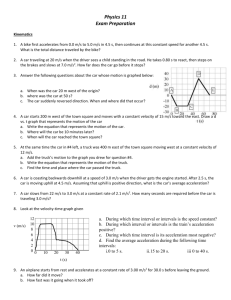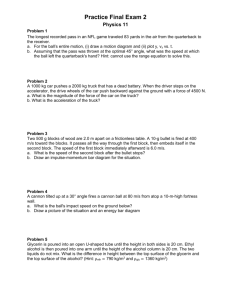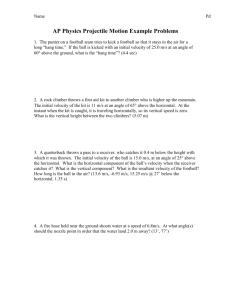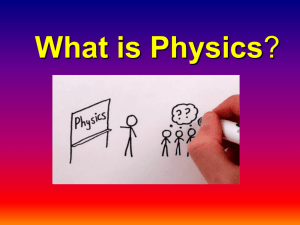Physics 11 Comprehensive Exam Preparation
advertisement
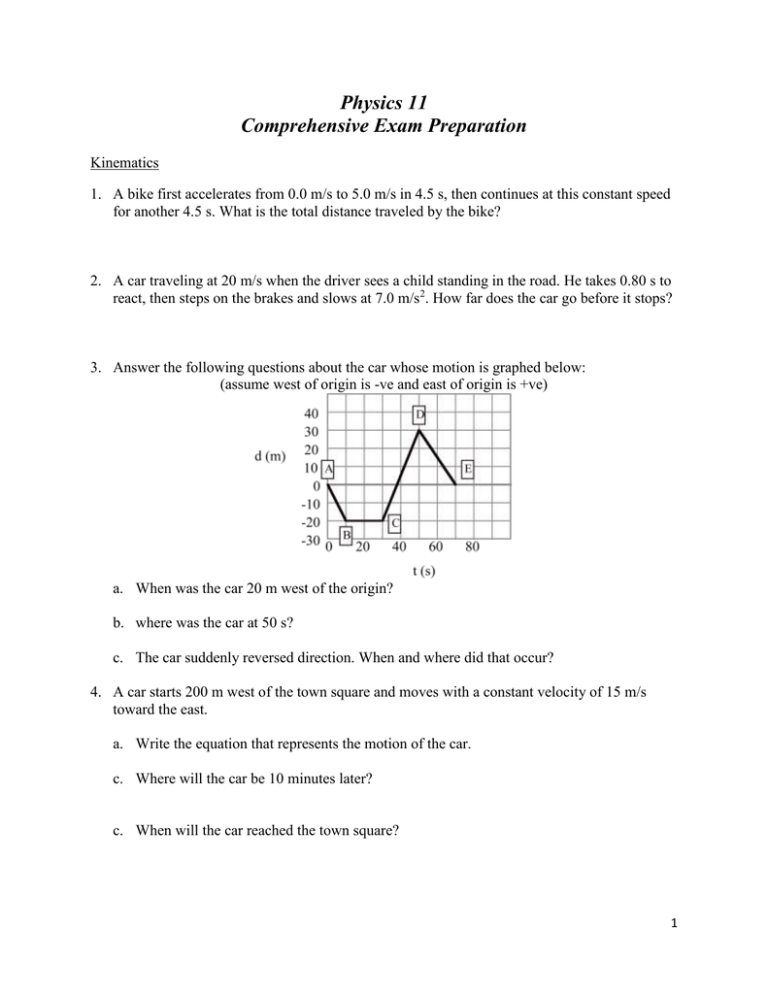
Physics 11 Comprehensive Exam Preparation Kinematics 1. A bike first accelerates from 0.0 m/s to 5.0 m/s in 4.5 s, then continues at this constant speed for another 4.5 s. What is the total distance traveled by the bike? 2. A car traveling at 20 m/s when the driver sees a child standing in the road. He takes 0.80 s to react, then steps on the brakes and slows at 7.0 m/s2. How far does the car go before it stops? 3. Answer the following questions about the car whose motion is graphed below: (assume west of origin is -ve and east of origin is +ve) a. When was the car 20 m west of the origin? b. where was the car at 50 s? c. The car suddenly reversed direction. When and where did that occur? 4. A car starts 200 m west of the town square and moves with a constant velocity of 15 m/s toward the east. a. Write the equation that represents the motion of the car. c. Where will the car be 10 minutes later? c. When will the car reached the town square? 1 5. At the same time the car in #4 left, a truck was 400 m east of the town square moving west at a constant velocity of 12 m/s. a. Write the equation that represents the motion of the truck. b. Find the time and place where the car passed the truck. 6. A car is coasting backwards downhill at a speed of 3.0 m/s when the driver gets the engine started. After 2.5 s, the car is moving uphill at 4.5 m/s. Assuming that uphill is positive direction, what is the car’s average acceleration? 7. A car slows from 22 m/s to 3.0 m/s at a constant rate of 2.1 m/s2. How many seconds are required before the car is traveling 3.0 m/s? 8. Look at the velocity-time graph given a. During which time interval or intervals is the speed constant? b. During which interval or intervals is the train’s acceleration positive? c. During which time interval is its acceleration most negative? d. Find the average acceleration during the following time intervals: i. 0 to 5 s. ii. 15 to 20 s. iii 0 to 40 s. 2 9. An airplane starts from rest and accelerates at a constant rate of 3.00 m/s2 for 30.0 s before leaving the ground. a. How far did it move? b. How fast was it going when it took off? 10. A brick is dropped from a high scaffold. a. What is its velocity after 4.0 s? b. How far does the brick fall during this time? 11. A tennis ball is thrown straight up with an initial speed of 22.5 m/s. It is caught at the same distance above the ground. a. How high does the ball rise? b. How long does the ball remain in the air? 12. Consider the following velocity-time graph. Determine the displacement after t = ... a. 10 s. b. 20 s. c. 30 s. d. 40 s. 13. A bag is thrown horizontally with a speed of 20 m/s from a helicopter hovering 15 m above the ground. a. what is the bag’s velocity when it hits the ground? How far (horizontally) has it travelled? b. if the helicopter is moving upwards at 10 m/s when the bag is thrown 15 m above the ground. How long has the bag been in the air for? 3 Dynamics 1. A boy exerts a 36 N horizontal force as he pulls a 52 N sled across a cement sidewalk at a constant speed. What is the coefficient of friction between the sidewalk and the metal sled runners? 2. A 50 kg bucket is being lifted by a rope. The rope is guaranteed not to break if the tension is 500 N or less. The bucket started at rest, and after being lifted 3.0 m, it is moving at 3.0 m/s. Assuming that the acceleration is constant, is the rope in danger of breaking? 3. A car brakes to a halt. What forces act on the car? What are the other parts of the actionreactions pairs to which those forces belong? On what objects are they exerted? 4. A 4500 kg helicopter accelerates upward at 2.0 m/s2. What lift force is exerted by the air on the propellers? 5. A force of 40.0 N accelerates a 5.0 kg block at 6.0 m/s2 along a horizontal surface. a. How large is the frictional force? b. What is the coefficient of friction? 6. A spring is stretched by a mass hooked to the end. The mass is 200 g and the spring constant is 7.5 N/m. How much has the spring been stretched? 7. As a baseball is being caught, its speed goes from 30.0 m/s to 0.0 m/s in about 0.0050 s. The mass of the baseball is 0.145 kg. a. What is the baseball’s acceleration? b. What are the magnitude and direction of the force acting on it? c. What is the magnitude and direction of the force acting on the player who caught it? 8. The gravitational force between two electrons 1.00 m apart is 5.42 x 10-71 N. Find the mass of an electron. 9. Two bowling balls each have mass of 6.8 kg. They are located next to each other with their centres 21.8 cm apart. What gravitational force do they exert on each other? 4 10. A 1.25 kg book in space has a weight of 8.35 N. What is the value of the gravitational field at that location? 11. The asteroid Ceres has a mass of 7.0 x 1020 kg and a radius of 500 km. a. What is the gravitational field strength on the surface? b. How much would a 85 kg astronaut weigh on Ceres? 12. A car with mass of 725 kg is moving at 100 km/h to the east. a. What is the magnitude and direction of its momentum? b. A second car with mass 2175 kg, has the same momentum. What is its velocity? 13. A 0.144 kg baseball is pitched horizontally at 38.0 m/s. After the bat hits it, it moves at the same speed, but in opposite direction. a. What was the momentum of the ball before it hit the bat? After it hit the bat? b. What was the change in momentum of the ball? c. What was the impulse delivered by the bat? d. If the bat and ball were in contact for 0.80 ms (milliseconds), what was the average force the bat exerted on the ball? 14. A 0.105 kg hockey puck moving at 24 m/s is caught and held by a 75 kg goalie at rest. With what speed does the goalie slide on the ice? 15. A 35.0 g bullet moving at 475 m/s strikes a 2.5 kg block of wood at rest. The bullet passes through the block, leaving at 275 m/s. How fast is the block moving when the bullet leaves? 16. Find the tension in the cable. 5 Work, Power, Energy and Momentum 1. A student lifts a box of books that weighs 185 N. The box is lifted 0.800 m. How much work does the student do on the box? 2. Two students together exert a force of 878 N in pushing a car 28 m. a. How much work do they do on the car? b. If the force were doubled, how much work would they do pushing the car the same distance? 3. A 0.220 kg ball falls 2.9 m. How much work does the force of gravity do on the ball? 4. A box that weighs 888 N is lifted a distance of 16.5 m straight up by a cable attached to a motor. The job is done in 10.0 s. What power is developed by the motor in watts and kilowatts? 5. A rock climber wears a 12.4 kg knapsack will scaling a cliff. After a half an hour, the climber is 11.2 m above the staring point. a. How much work does the climber do on knapsack? b. If the climber weighs 705 N, how much work does she do lifting herself and the knapsack? c. What is the average power of the climber? 6. An electric motor develops 89 kW of power as it lifts a loaded elevator 15.5 m in 42 s. How much force does the motor exert? 7. A machine does 4500 J of work in 60 s. If the motor is supplied with 120 W of electric power to run, how efficient is it? 6 8. A comet with a mass of 7.85 x 1011 kg strikes the Earth at a speed of 25.0 km/s. a. Find the kinetic energy of the comet in joules. b. How much work does the Earth do to stop the comet? 9. A rifle can fire a 38.0 g bullet at a speed of 825 m/s. a. What is the bullet’s kinetic energy as it leaves the gun? b. What work is done on the bullet when it is fired? c. If the work is done over the barrel of the gun which is 0.60 m long, what was the average force applied to the bullet? 10. A cannonball (m = 45 kg) is shot from the ground to a height of 425 m. a. What is the gravitational potential energy of the cannonball at this height? b. What is the change in the potential energy when the cannonball falls to a height of 200 m? 11. A elastic band with k = 11.2 N/m is stretched 15 cm. What is the force exerted by the band? 12. A bike rider approaches a hill at a speed of 7.7 m/s. The mass of the bike and rider is 88 kg. a. What is the kinetic energy of the system? b. Assuming no friction, how far will the bike coast up the hill? 13. Tarzan swings down on a 20 m vine from a tree branch 15 m above the ground to a second branch 4.0 m above the ground. If Tarzan has a mass of 85 kg, how fast would he be swinging when he reaches the second branch? 7 14. How much heat is absorbed by 70.0 g of copper when its temperature is raised from 25.0ºC to 75.0ºC? (c for copper = 385 J/kg/ºC) 15. The cooling system of a car engine contains 20.0 L of water (1 L of water = 1 kg). a. What is the change in the temperature of the water if the engine operates until 956 kJ of heat is added? (c for water = 4180 J/kg/ºC) b. Suppose it is winter and the system is filled with methanol instead of water (methanol: density = 0.80 g/mL; c = 2450 J/kg/ºC). What would be the increase in temperature of the methanol if the same heat was absorbed as in part a, 956 kJ? 16. Five solar panels, each 2.0 m2 in area, area used to power a hot water tank. a. Assuming the Sun delivers 1354 W/m2 of power to the panels how much power do the panels receive in total? b. The water tank has a capacity of 2000 L. How much energy would be required from the panels to raise the temperature of a full tank of water by 60ºC? c. How long would it take? Waves And Optics 1. The CN Tower in Toronto sways back and forth in the wind with a frequency of 0.10 Hz. a. What is its period of vibration? b. How many times does it say back and forth in one minute? 2. An ocean wave has a length of 12.0 m. A wave passes a fixed location every 1.8 s. What is the speed of the wave? 8 3. Water waves in a shallow dish are 6.0 cm long. At one point, the water oscillates up and down at a rate of 4.8 Hz. a. What is the speed of the water waves? b. What is the period of the water waves? 4. Water waves in a lake travel 5.6 m in 2.3 s. The period of oscillation is 1.32 s. a. What is the speed of the water waves? b. What is their wavelength? 5. AM-Radio signals are broadcast at frequencies between 550 kHz and 1600 kHz (kilohertz) and travel at 3.00 x 108 m/s. a. What is the range of wavelength for these signals? b. FM-radios signals ranges from 88 MHz to 108 MHz (megahertz) and travel at the same speed. What are the range of FM wavelengths? 6. A wave that travels back and forth within a closed, bounded medium is called a standing wave. If you make waves in a bathtub at a correct frequency, the water can first rise at one end and then at the other, making what looks like one large, standing wave. Suppose you do this in a bathtub, which is 1.40 m long with a frequency of 0.25 Hz? What is the velocity of the water wave? 7. A ray of light strikes a mirror at an angle of 47º to the normal. a. What is the angle of reflection? b. What is the angle between the incident and reflected rays? 8. A ray of light has an angle of incidence of 30.0º on a block of quartz and an angle of refraction of 20.0º. What is the index of refraction for this block of quartz? 9. Light is incident on the surface of a diamond at an angle of 60º. Find the angle of refraction (n = 2.42) 9 10. Light from a submarine is incident to the surface of the water at an angle of 33º. Find the angle of refraction (n = 1.33 for water). 11. What is the speed of light in a diamond? 12. The speed of light in a certain substance is 2.11 x 108 m/s. What is its index of refraction? 13. Find the critical angle for diamond. 14. A block of glass has a critical angle of 48.7º. What is its index of refraction? 15. The critical angle for a special glass is 42.3º. What is the critical angle if the glass is immersed in water? 16. Determine the binding energy of 2965Cu in joules. mcu= 64.927791u mp= 1.007825u mn=1.008665u 1u=931.49 MeV 1eV=1.602 × 10-19 J 17. A certain star is 10.6 light-years away (A light-year is the distance that light travels in one year. (1 Lt- y = 9.5 x 1015 m!) How long would it take a spaceship travelling at 0.96c to reach the star: a. As measured by stationary observers on Earth? b. As measured by observers on the spaceship? c. What is the distance travelled according to observers on the spaceship? 10 Comprehensive Exam Preparation – Answer Key Kinematics 1. 34 m 2. 45 m 3. (assuming west of origin is -ve and east of origin is +ve) a. 10-30 s (B to C) b. 30 m east of origin (part D) m east of origin (and part C, t=30s, 20m west of origin) 4. a. d = 15 m/s t - 200 m b. 8.8 km east c. 13 s 5. a. d = -12 m/s t + 400 m b. they pass when d = 130 m and t = 22 s 6. + 3.0 m/s2 7. 9.0 s 8. a. t = 5 s to t = 15 s b. t = 0 to t = 5 s d. i) 2 m/s2 ii) -1.2m/s2 iii) 0 9. a. 1.35 x 103 m b. 90.0 m/s 10. a. 39 m/s, down b. 78 m 11. a. 25.8 m b. 4.59 s 12. a. 40 m b. 130 m c. 230 m 13. a. 26.3 m/s 40.60below horizontal, dx=35 m b. 3.0 s c. t = 50 s, 30 c. t = 15 s to t = 20 s d. 265 m Dynamics 1. 2. 4. 5. 6. 7. 0.69 Yes... force of tension on the rope is equal to 565 N 5.3 x 104 N a. 10 N b. 0.20 0.26 m a. -6.0 x 103 m/s2 b. 8.7 x 102 m/s2, opposite the original path of the ball. c. 8.7 2 2 x 10 m/s , towards the player. 8. 9.01 x 10-31 kg 9. 6.5 x 10-8 N 10. 6.68 N/kg 11. a. 0.19 N/kg b. 16 N 12. a. 2.01 x 104 kg·m/s, east b. 9.25 m/s 13. a. 5.47 kg·m/s; -5.47 kg·m/s b. -10.9 kg·m/s c. -10.9 kg·m/s d. 1.37 x 104 N 14. 3.4 x 10-2 m/s 15. 2.8 m/s 16. 6.9 N Work, Power, Energy and Momentum 1. 148 J 2. a. 2.5 x 104 J b. doubled 11 3. 6.3 J 4. 1.47 x 103 W; 1.47 kW 5. a. 1.36 x 103 J 6. 2.4 x 105 N 7. 63% 8. a. 2.45 x 1020 J 9. a. 1.29 x 104 J 10. a. 1.9 x 105 J 11. 1.68 N 12. a. 2.6 x 103 J 13. 15 m/s 14. 1.35 x 103 J 15. a. +11.4ºC 16. a. 1.4 x 104 W b. 9.26 x 103 J c. 5.14 W b. -2.45 x 1020 J b. 1.29 x 104 J b. -9.9 x 104 J c. 2.16 x 104 N b. 3.0 m b. +24.4ºC b. 5.0 x 108 J c. 3.7 x 104 s or 10 hours Waves And Optics 1. a. 10 s b. 6.0 2. 6.7 m/s 3. a. 0.29 m/s b. 0.21 s 4. a. 2.4 m/s b. 3.2 m 5. a. 545 m to 188 m b. 3.41 m to 2.78 m 6. 0.70 m/s 7. a. 47º b. 94º 8. 1.46 9. 21º 10. 46º 11. 1.24 x 108 m/s 12. 1.42 13. 24.4º 14. 1.33 15. 63.5º 16. 9.12 x 10-11 J 17. a) 11.04 y b) 3.1 y c) 2.967 lt-y 12
